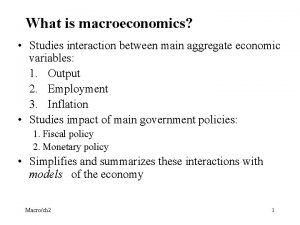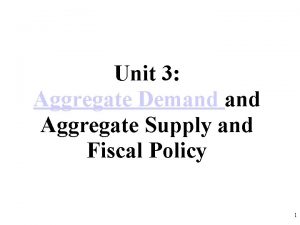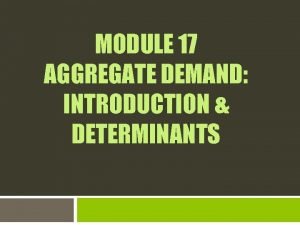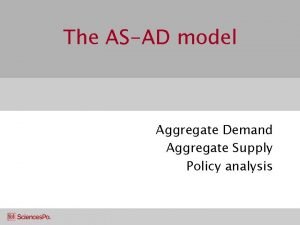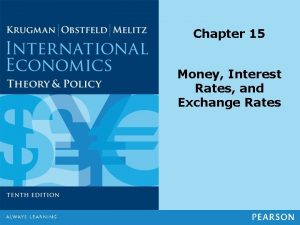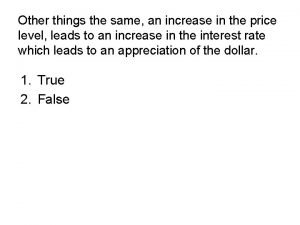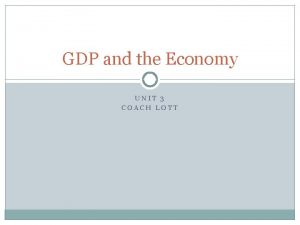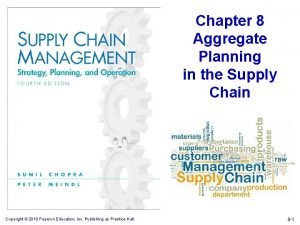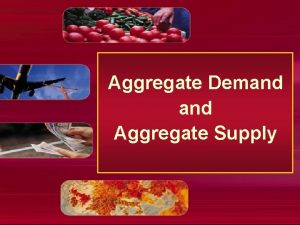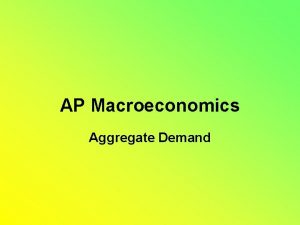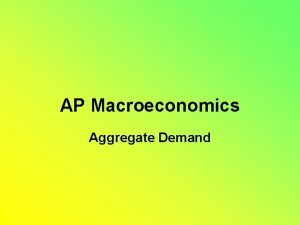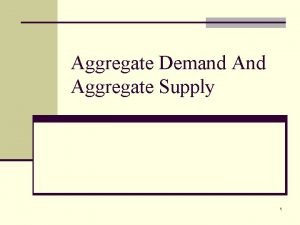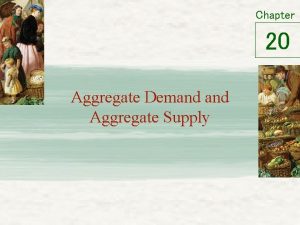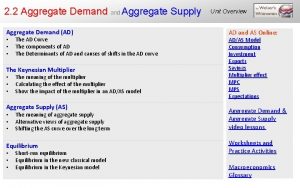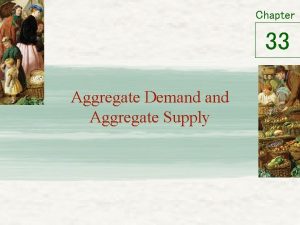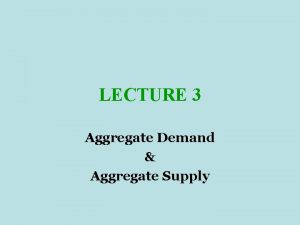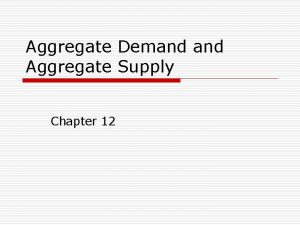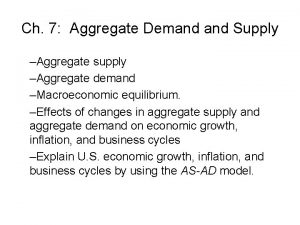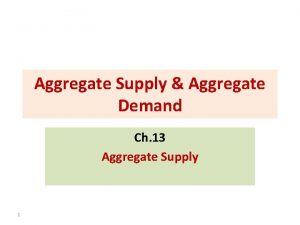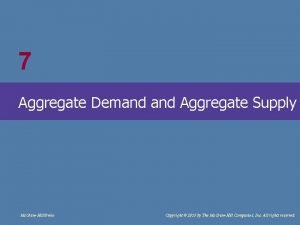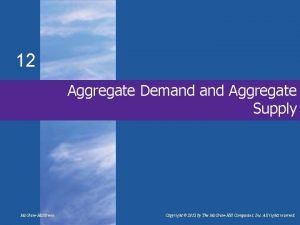29 Aggregate Demand Aggregate Supply Mc GrawHillIrwin Copyright

























- Slides: 25

29 Aggregate Demand Aggregate Supply Mc. Graw-Hill/Irwin Copyright © 2012 by The Mc. Graw-Hill Companies, Inc. All rights reserved.

Aggregate Demand • • LO 1 Real GDP desired at each price level Inverse relationship § Real balances effect-change in the price level. An increase in the price level reduces the real value of purchasing power which leads to less CONSUMPTION. § Interest effect-if we assume the supply of money to be fixed, higher prices lead to a shortfall of dollars. Thus the demand for money rises, increasing the interest rate. This leads to less C and Ig. § Foreign purchases effect-when the U. S. price level rises, foreigners will buy____goods and Americans will buy _____ foreign goods. 29 -2

Price level Aggregate Demand AD 0 LO 1 Real domestic output, GDP 29 -3

Price level Changes in Aggregate Demand AD 2 0 AD 3 AD 1 Real domestic output, GDP LO 1 29 -4

Consumer Spending • • LO 1 Consumer wealth-assets minus liabilities • More wealth =____. Household borrowing Consumer expectations • if we expect our future incomes to rise we will spend more now. • If we expect prices to rise in the future we may also spend now. Personal taxes 29 -5

Investment Spending • • LO 1 Real interest rates-an increase raises borrowing costs. Expected returns • Expectations about future business conditions • If businesses think the economy will be better in the future they will forecast higher rates of return. • Technology • Degree of excess capacity-TOO much excess capacity gives businesses little incentive to INVEST more. • Business taxes 29 -6

Government Spending • Government spending increases • Aggregate demand increases (as • LO 1 long as interest rates and tax rates do not change) • More transportation projects Government spending decreases • Aggregate demand decreases • Less military spending, less unemployment 29 -7

Net Export Spending • National income abroad • Exchange rates • Dollar depreciation-? ? ? • Dollar appreciation-? ? ? LO 1 29 -8

Aggregate Supply • Total real output produced at each • LO 2 price level Relationship depends on time horizon • Immediate short run • Short run-flat up to full emp. then rises quickly. WHY? • Long run- Why is it vertical? 29 -9

AS: Immediate Short Run Price level Immediate-short-run aggregate supply P 1 0 ASISR Qf Real domestic output, GDP LO 2 29 -10

Aggregate Supply: Short Run AS Price level Aggregate supply (short run) 0 Qf Real domestic output, GDP LO 2 29 -11

Aggregate Supply: Long Run Price level ASLR Long-run aggregate supply 0 Qf Real domestic output, GDP LO 2 29 -12

Changes in Aggregate Supply • Determinants of aggregate supply • Shift factors • Changes raise or lower per-unit production costs LO 2 29 -13

Changes in Aggregate Supply AS 3 AS 1 Price level AS 2 0 Real domestic output, GDP LO 2 29 -14

Input Prices • Domestic resource prices • Labor • Capital • Land • Prices of imported resources • Imported oil • Exchange rates LO 2 29 -15

Productivity • Real output per unit of input • Increases in productivity reduce costs • Decreases in productivity increase costs Productivity = Per-unit production cost LO 2 total output total inputs = total input cost total output 29 -16

Legal-Institutional Environment • LO 2 Legal changes alter per-unit costs of output • Taxes and subsidies • Extent of government regulation • More could lead to less agg. supply, however, if deregulation leads to unfair and unsafe business practices, it could move the other direction. • Also, if agg. demand is strong enough, would businesses really cut back? 29 -17

Price level (index numbers) Equilibrium AS 100 a 92 b Real Output Demanded (Billions) Price Level (Index Number) Real Output Supplied (Billions) $506 108 $513 508 104 512 510 100 512 96 507 514 92 502 AD 0 502 510 514 Real domestic output, GDP (billions of dollars) LO 3 29 -18

Increases in AD: Demand-Pull Inflation Price level AS P 2 P 1 AD 2 AD 1 0 Qf Q 1 Q 2 Real domestic output, GDP LO 4 29 -19

Why? • Firms boost investment spending because they anticipate higher future profits from investments in new capital. • Government increases spending for such programs as national defense.

Decreases in AD: Recession Price level AS P 1 P 2 b a c AD 1 AD 2 0 Q 1 Q 2 Qf Real domestic output, GDP LO 4 29 -21

Prices? • Sticky prices • Costs do not necessarily change-menu costs, minimum wage, wage contracts • Morale, productivity-wage inflexibility • Price wars

Decreases in AS: Cost-Push Inflation Price level AS 2 P 1 AS 1 b a AD 0 Q 1 Qf Real domestic output, GDP LO 4 29 -23

Increases in AS: Full-Employment Price level AS 1 P 3 P 2 P 1 AS 2 b a c AD 2 AD 1 0 Q 1 Q 2 Q 3 Real domestic output, GDP LO 4 29 -24

 Aggregate demand and aggregate supply
Aggregate demand and aggregate supply Aggregate supply shifters
Aggregate supply shifters Unit 3 aggregate demand aggregate supply and fiscal policy
Unit 3 aggregate demand aggregate supply and fiscal policy Chapter 33 aggregate demand and aggregate supply
Chapter 33 aggregate demand and aggregate supply Unit 3 aggregate demand aggregate supply and fiscal policy
Unit 3 aggregate demand aggregate supply and fiscal policy Disaggregating the aggregate plan
Disaggregating the aggregate plan Aggregate supply shifters
Aggregate supply shifters Aggregate supply shifters
Aggregate supply shifters Aggregate supply and demand graph
Aggregate supply and demand graph Module 5 supply and demand introduction and demand
Module 5 supply and demand introduction and demand Matching supply with demand
Matching supply with demand Cannot mix aggregate and non-aggregate tableau
Cannot mix aggregate and non-aggregate tableau Real gdp formula
Real gdp formula Why is aggregate demand downward sloping
Why is aggregate demand downward sloping The aggregate real money demand schedule l(r,y)
The aggregate real money demand schedule l(r,y) Aggregate demand curve
Aggregate demand curve Asad model
Asad model The aggregate real money demand schedule l(r,y)
The aggregate real money demand schedule l(r,y) Which of the following shifts aggregate demand to the left?
Which of the following shifts aggregate demand to the left? Aggregate demand curve
Aggregate demand curve Fisher's equation
Fisher's equation Money market graph expansionary monetary policy
Money market graph expansionary monetary policy Recessionary gap aggregate demand
Recessionary gap aggregate demand Aggregate supply curve
Aggregate supply curve Aggregate planning in supply chain examples
Aggregate planning in supply chain examples Which aggregate supply curve has a positive slope
Which aggregate supply curve has a positive slope












